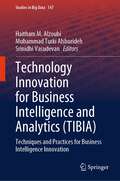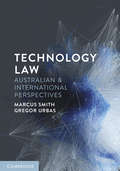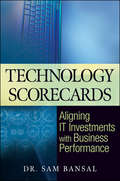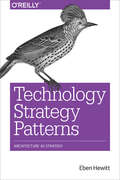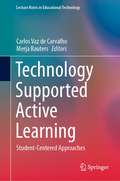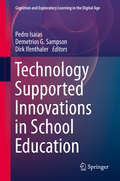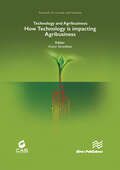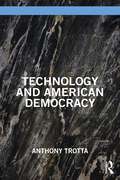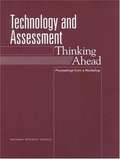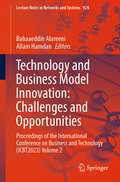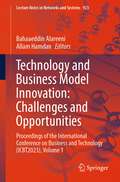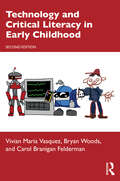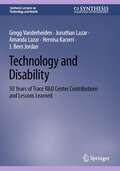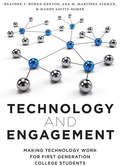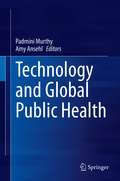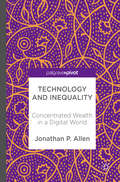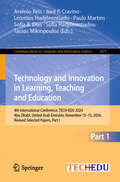- Table View
- List View
Technology In Action Complete, 13th Edition
by Alan Evans Kendall Martin Maryanne PoatsyFor introductory courses in computer concepts, digital literacy, or computer literacy, often including instruction in Microsoft Office. Explore, discover, and experience technology with the interactive and adaptive Technology in Action --the book that uses technology to teach technology! This book offers a learning system that pushes the envelope of what is possible in technology, and what is helpful in teaching. Although students are more comfortable with the digital environment than ever, their knowledge of the devices they use every day is still limited. The authors focus on tasks that students can accomplish with their devices, and skills they can apply immediately in the workplace, the classroom, and at home. This book fits the way students are learning today. Note: You are purchasing a standalone product; MyITLab does not come packaged with this content. Students, if interested in purchasing this title with MyITLab, ask your instructor for the correct package ISBN and Course ID. Instructors, contact your Pearson representative for more information
Technology Innovation for Business Intelligence and Analytics: Techniques and Practices for Business Intelligence Innovation (Studies in Big Data #147)
by Muhammad Turki Alshurideh Haitham M. Alzoubi Srinidhi VasudevanThis book provides a standpoint on how to effectively use technology innovation for business intelligence and analytics. It presents an approach that combines cutting-edge technological advancements with practical applications in the business world. The book covers a range of innovative technologies and how they can be applied to enhance business intelligence and analytics. It is primarily aimed at professionals in the business field data analysts and students studying subjects. This book is especially beneficial for those who want to grasp and apply the technological trends in making strategic business decisions. Its comprehensive coverage makes it an indispensable resource for anyone, in the intersection of technology and business analytics.
Technology Law: Australian and International Perspectives
by Marcus Smith Gregor UrbasThe regulation of technology is an important and topical area of law, relevant to almost all aspects of society. Technology Law: Australian and International Perspectives presents a thorough exploration of the new legal challenges created by evolving technologies, from the use of facial recognition technology in criminal investigations to the rise and regulation of cryptocurrencies. A well-written and fascinating introduction to technology law in Australia and internationally, Technology Law provides thorough coverage of the theoretical perspectives, legislation, cases and developing issues where technology and the law interact. The text covers data protection and privacy, healthcare technology, criminal justice technology, commercial transactions, cybercrime, social media and intellectual property, and canvasses the future of technology and technology law. Written by leading experts in the field, Technology Law is an excellent resource for law students and legal professionals with an interest in the area.
Technology Scorecards
by Sam BansalPlan, execute, and sustain a successful IT campaign with Sam Bansal's perfect scorecard approachFirst came the dot.com bust, then the IT squeeze. Despite software being the tail that wags the dog in most corporations, the cham-pions of IT, the CIOs, are constantly under fire to justify and maximize their IT investments--past, present, and future.Learn how to establish Key Performance Indicators and Value Scorecards for IT to ensure maximum value in your corporation with the step-by-step approach found in Sam Bansal's Technology Scorecards.Drawing on Dr. Bansal's over forty years of field experience in the management of large and complex projects, Technology Scorecards shows you how to:Create Scorecards geared towards your organization's business goalsMake quantum improvements in cost, value, and productivity using KPIs and ScorecardsIncrease your company's net by as much as 100% just by improving your supply chain management by 50%Impact your top line the most through product life-cycle managementDevelop a realistic strategy through Scorecards, which can then be used to drive IT investments that maximize your business performanceEnhance profitability. Streamline strategy execution. Lower costs. Learn how to align your IT plans with your business objectives and optimize your company's overall performance with the perfect scorecard approach found in Technology Scorecards.
Technology Strategy Patterns: Architecture as Strategy
by Eben HewittTechnologists who want their ideas heard, understood, and funded are often told to speak the language of businessâ??without really knowing what that is. This bookâ??s toolkit provides architects, product managers, technology managers, and executives with a shared languageâ??in the form of repeatable, practical patterns and templatesâ??to produce great technology strategies.Author Eben Hewitt developed 39 patterns over the course of a decade in his work as CTO, CIO, and chief architect for several global tech companies. With these proven tools, you can define, create, elaborate, refine, and communicate your architecture goals, plans, and approach in a way that executives can readily understand, approve, and execute.This book covers:Architecture and strategy: Adopt a strategic architectural mindset to make a meaningful material impactCreating your strategy: Define the components of your technology strategy using proven patternsCommunicating the strategy: Convey your technology strategy in a compelling way to a variety of audiencesBringing it all together: Employ patterns individually or in clusters for specific problems; use the complete framework for a comprehensive strategy
Technology Supported Active Learning: Student-Centered Approaches (Lecture Notes in Educational Technology)
by Carlos Vaz de Carvalho Merja BautersThis book promotes student-centered approaches to the learning process, allowing students to develop skills and competences that traditional, passive learning methods cannot foster. In turn, supporting active learning with digital technology tools creates new possibilities in terms of pedagogical design and implementation. This book addresses the latest research and practice in the use of technology to promote active learning. As such, on the one hand, it focuses on active pedagogical methodologies like problem-based learning, design thinking and agile approaches; on the other, it presents best practice cases on the use of digital environments to support these methodologies. Readers will come to understand and learn to apply active learning methodologies, either by replicating the best practices presented here, or by creating their own methods.
Technology Supported Innovations in School Education (Cognition and Exploratory Learning in the Digital Age)
by Dirk Ifenthaler Pedro Isaias Demetrios G. SampsonThis volume provides a comprehensive and contemporary depiction of the swift evolution of learning technologies and the innovations that derive from their deployment in school education. It comprises cases studies, research focused on emergent technologies and experiments with existing tools in a wide range of scenarios. The studies included in this volume explore the conceptual and practical aspects of technologies that are used to support learning, with a multidisciplinary approach that encompasses all levels of education. The three sections of this volume emphasise the use of digital technologies from the viewpoint of different fields of expertise, explore multiple educational settings where technology was implemented to support the various stages of the learning process, and underline strategies, tools and technologies that play a crucial role in the professional development of teachers.
Technology Today & Tomorrow (3rd Edition)
by James F. Fales Vincent F. Kuetemeyer Sharon BrusicTeaches you about the numerous advances being made in the different areas of technology.
Technology Today & Tomorrow (Third Edition)
by James F. Fales Vincent F. Kuetemeyer Sharon BrusicTeaches you about the numerous advances being made in the different areas of technology.
Technology Transfer Between the US, China and Taiwan: Moving Knowledge (Routledge Research on Taiwan Series)
by Douglas B. Fuller Murray A. RubinsteinExamining the flow of technical knowledge between the US, Taiwan and Mainland China over the last sixty-five years, this book shows that the technical knowledge that has moved between these states is vast and varied. It includes the invention and production of industrial goods, as well as knowledge of the patterns of corporate organization and management. Indeed, this diversity is reflected in the process itself, which is driven both by returning expatriates with knowledge acquired overseas and by successful government intervention in acquiring technology from multinational firms. Technology Transfer Between the US, China and Taiwan engages with the evolving debates on the merits, importance and feasibility of technology transfer in the process of economic development globally, and uses the example of Taiwan to show that multinational corporations can indeed play a positive role in economic development. Further, it reveals the underlying tension between international cooperation and nationalism which inevitably accompanies international exchanges, as well as the delicate balancing act required between knowledge acquisition and dangerous levels of dependency, and the beneficial role of the US in East Asia’s technological development. With contributors from disciplines ranging from history, geography, urban planning, sociology, political science and electrical engineering, this multi-disciplinary book will be of great interest to students and scholars working across a broad range of subjects including Taiwan studies, Chinese studies, economics, business studies and development studies.
Technology Transfer Systems in the United States and Germany: Lessons and Perspectives
by Proctor P. Reid H. Norman Abramson Jose Encarnacao Ulrich SchmochThis book explores major similarities and differences in the structure, conduct, and performance of the national technology transfer systems of Germany and the United States. It maps the technology transfer landscape in each country in detail, uses case studies to examine the dynamics of technology transfer in four major technology areas, and identifies areas and opportunities for further mutual learning between the two national systems.
Technology and Agribusiness: How the Technology is Impacting the Agribusiness
by Yoshifumi Nishio Amara Amara Yen-Kuang ChenThe world population is growing, and it is expected that in 2050 there will be 9.7 billion inhabitants on the Earth. According to FAO (United Nations, Food and Agriculture Organization) we need to increase the productivity of agriculture by between 50% and 70% to be able to feed the world population in 2050. Other researchers think that reducing the wastage of food may be enough to handle the 2050 population.Several factors must be considered to ensure that humanity is able to feed the world’s population in 2050 and beyond.• Less arable land: As cities are growing, the space available for agriculture is shrinking.• Climate change: Dramatic impacts on agribusiness.• Role of agribusiness on GHG emissions.• Planetary boundaries and the role of agribusiness.• Availability of freshwater.• Soil degradation.The seasonal school presents and discusses the major problems that agribusiness is facing and the different technologies that can be applied to solve and improve such issues. Specific case studies are presented along with the technological solutions that have been applied to solve or minimize the impact.Agribusiness covers different topics such as arable farming, dairy farming, fruits, vegetables, meat, etc. Each of these domains has different needs that can be addressed through smart agriculture technologies such as circuits and systems. Also, these domains affect the sustainability of the planet as they impact at least 4 out of the 9 planetary boundaries.
Technology and American Democracy
by Anthony TrottaThe growth and proliferation of technology in American society places new demands on the U.S. government and the health of its democracy, affecting both policymaking and public administration. Technology and American Democracy explores the underpinning democratic theories, including constitutional justifications, that guide decision makers during the application of Information Technology (IT) in governance to promote democratic principles such as transparency and accountability. The book examines the capacity of IT to facilitate deliberative democracy, alter modern bureaucratic structures and functions, and affect areas of public policy including public budgeting and performance measurement. Author Anthony Trotta demonstrates the ways in which technology creates new problems for contemporary government, including a discussion of virtual currency and its possible issues that must be addressed by the public sector. The discussion avoids highly technical language and confusing industry jargon, focusing instead on explaining important concepts in an accessible fashion, applicable to a broad spectrum of readers. Technology and American Democracy is required reading for students enrolled in courses on politics, public administration, and public policy.
Technology and Assessment: Proceedings from a Workshop
by National Research CouncilA report on Technology and Assessment:Thinking Ahead
Technology and Business Model Innovation: Proceedings of the International Conference on Business and Technology (ICBT2023) Volume 2 (Lecture Notes in Networks and Systems #924)
by Allam Hamdan Bahaaeddin AlareeniThis book proceedings addresses a crucial gap in understanding the impact of technology on Business Model Innovation (BMI). It emphasizes the need for further research to explore the intricate relationship between technology and BMI, focusing on opportunities and challenges. By delving into how technology influences emerging business model innovations and enhances operational efficiency, the publication aims to advance knowledge. Inviting diverse research methods, it sheds light on various ideas within the technology and BMI realm. Tailored for students, scholars, professionals, and policymakers, this book contributes to the evolving field of BMI and technology.
Technology and Business Model Innovation: Proceedings of the International Conference on Business and Technology (ICBT2023), Volume 1 (Lecture Notes in Networks and Systems #923)
by Allam Hamdan Bahaaeddin AlareeniThis book proceedings addresses a crucial gap in understanding the impact of technology on Business Model Innovation (BMI). It emphasizes the need for further research to explore the intricate relationship between technology and BMI, focusing on opportunities and challenges. By delving into how technology influences emerging business model innovations and enhances operational efficiency, the publication aims to advance knowledge. Inviting diverse research methods, it sheds light on various ideas within the technology and BMI realm. Tailored for students, scholars, professionals, and policymakers, this book contributes to the evolving field of BMI and technology.
Technology and Critical Literacy in Early Childhood
by Vivian Maria Vasquez Carol Branigan Felderman Bryan WoodsNow in its second edition, this popular text explores classrooms where technology and critical literacies are woven into childhood curricula and teaching. Using real-world stories, it addresses what ICTs afford critical literacy with young children, and how new technologies can be positioned to engage in meaningful and authentic learning. Concise but comprehensive, the text provides strategies, theoretical frameworks, demonstrations of practice, and resources for teachers. Updated with discussions of media literacy and new pedagogical tools, the second edition features new classroom examples and experiences that highlight the ways in which critical literacy, technology and media literacy come together in everyday life in the early childhood classroom. The inviting examples model how to use the interests and inquiry questions of young learners as a springboard for creating a critical curriculum. Each chapter includes Reflection Points, pedagogical invitations, and Resource Boxes to imagine new possibilities of working with students in engaging and supportive ways. The inspiring stories, guidance, and tools this book make it a great resource for pre-service teachers and students in Early Childhood Education and Literacy Education, and primary teachers and educators.
Technology and Critical Literacy in Early Childhood
by Vivian Maria Vasquez Carol Branigan FeldermanWhat do new technologies and new forms of communication mean for young children growing up in the 21st century? How are they shaping the mindsets, identities and practices which impact their lives at home and at school? This book explores the intersection of technology and critical literacy, specifically addressing what ICTs afford critical literacy work with young children between ages three to eight. Inviting readers to enter classrooms where both technology and critical literacies are woven into childhood curricula and teaching, it brings together literacy, social studies, and science in critical and integrated ways. Real-world stories show the sights and sounds of children engaged with technology in the classroom and beyond. Concise but comprehensive, the text provides strategies, theoretical frameworks, demonstrations of practice, and resources for teachers. Pedagogical features in each chapter engage readers in making connections to their own teaching situations. NCATE standards for including technology as an essential part of teacher education programs are addressed. While acknowledging how individual children employ ICT, the focus is on how new technologies can be positioned in early childhood learning communities as tools for engaging in more meaningful, authentic, and interesting learning.
Technology and Digital Media in the Early Years: Tools for Teaching and Learning
by Chip DonohueThis book provides strategies, theoretical frameworks, links to research evidence, descriptions of best practice, and resources to develop essential digital literacy knowledge, skills, and experiences for early childhood educators in the digital age.
Technology and Disability: 50 Years of Trace R&D Center Contributions and Lessons Learned (Synthesis Lectures on Technology and Health)
by Jonathan Lazar Gregg Vanderheiden Amanda Lazar Hernisa Kacorri J. Bern JordanThis book outlines the development of the Trace R&D Center as an institution for furthering accessible and assistive technologies. The book walks readers through the Center’s nascent attempts to solve individual challenges with augmentative communication devices through contemporary efforts to establish global frameworks and infrastructures for accessibility. This book is premised on the Center’s mission to maximize the potential of people with disabilities by harnessing evolving technologies while at the same time dismantling the barriers created by those same technological advancements. Readers will learn how this has been done in the past and why this practice should be a fundamental and integrated feature in new technology planning and implementation. The book touches on pre-internet technologies before exploring the huge implications of, first, the personal computer and, second, the Internet. In parallel with the massive growth in scale rendered by the launch of the Web, the book traces the expansion of the Center’s focus from the individual to the universal, particularly in working to establish accessibility standards and infrastructures. Learning from the successes and failures of the Center, the book outlines many past challenges and future directions for the development of technologies for people with disabilities from the research and industry perspectives.
Technology and Engagement: Making Technology Work for First Generation College Students
by Mandy Savitz-Romer Heather T. Rowan-Kenyon Ana M. Martínez AlemánTechnology and Engagement is based on a four-year study of how first generation college students use social media, aimed at improving their transition to and engagement with their university. Through web technology, including social media sites, students were better able to maintain close ties with family and friends from home, as well as engage more with social and academic programs at their university. This ‘ecology of transition’ was important in keeping the students focused on why they were in college, and helped them become more integrated into the university setting. By showing the gains in campus capital these first-generation college students obtained through social media, the authors offer concrete suggestions for how other universities and college-retention programs can utilize the findings to increase their own retention of first-generation college students.
Technology and Forced Migration: Ukrainian Migrants in Central and Eastern Europe (Routledge Advances in Regional Economics, Science and Policy)
by Ewa Ślęzak-Belowska Marie Jelínková Agnieszka Bielewska Karin AmitThe Russian aggression on Ukraine has drastically altered the migration situation in Central and Eastern Europe (CEE), drawing international attention. Despite numerous global studies on individuals seeking refuge, CEE remains underresearched. This book details the recent, lesser-known experiences of countless forced migrants who arrived there.Given the pivotal role of information and telecommunication technologies (ICTs) for both migrants and host societies, the book explores the intersection of ICTs and forced migration. With this in mind, the book focuses on Poland, Czechia, Slovakia, and Hungary, and uses comprehensive research and robust qualitative methods to demonstrate how these countries are emerging as New Immigration Destinations and handling the influx of Ukrainians. Contributions from economists, sociologists, and political scientists provide a thorough examination of how Ukrainian forced migrants navigate their lives using modern technologies, as well as their impact on these technologies.Essential reading for academics, policymakers, and professionals in the fields of migration studies, digital governance, and European affairs, this book uniquely highlights the vital role of ICTs in migration decisions, journeys, settlement, and integration. It provides a balanced mix of theoretical analysis and practical insights, helping readers comprehend the interplay between ICTs and migration. Readers will obtain a better understanding of the challenges and opportunities that digital technologies bring in facilitating and regulating forced migration in this part of Europe.
Technology and Global Public Health
by Padmini Murthy Amy AnsehlThis book explores the pivotal role played by technology over the past decade in advancing global public health and health care. At present, the global community faces unprecedented healthcare challenges fueled by an aging population, rising rates of chronic disease, and persistent health disparities. New technologies and advancements have the potential to extend the reach of health professionals while improving quality and efficiency of service delivery and reducing costs within the public and the private health systems. The chapters highlight the barriers faced by the global healthcare workforce in using technology to promote health and human rights of communities:Role of Digital Health, mHealth, and Low-Cost Technologies in Advancing Universal Health Coverage in Emerging EconomiesTelehealth and Homecare AgenciesTechnology and the Practice of Health Education in Conflict ZonesThe Worldwide Digital Divide and Access to Healthcare TechnologyTechnology for Creating Better Professional Teams to Strengthen Healthcare SystemsGlobal Public Health Disaster Management and TechnologyAs a resource on the evolution of technology as a valuable and integral component in the promotion and practice of public health and health care, with a focus on SDG 3 targets, Technology and Global Public Health should engage students, instructors, practitioners, and other professionals interested in public health, universal health care, health technology, digital health, and health equity.Dr. Murthy has been a respected leader and mentor on scientific health-related matters within the UN system for many years. Her book develops a theoretical system connecting concepts that have coined global public health with the rapid development of technology, all with the focus to achieve Sustainable Development Goal number three, within the time frame set by World Leaders. - Henry L. Mac-Donald, Former Permanent Representative of Suriname to the United Nations
Technology and Inequality
by Jonathan P. AllenThis book will summarize what we know about technology and inequality across disciplines, and seek out new ways to analyze this relationship based on technology and business practices, with the objective of restoring digital technology as an engine of opportunity. Besides the unique focus on the role of technology in inequality, the book will have a unifying theme of tracing wealth creation and wealth capture in the technology sector, and relating specific practices--what technology companies actually do--to larger shifts in wealth and power. A clear conceptual framework will be used to analyze key industry case studies: search engines, social media, and the 'sharing' economy.
Technology and Innovation in Learning, Teaching and Education: 4th International Conference, TECH-EDU 2024, Abu Dhabi, United Arab Emirates, November 13–15, 2024, Revised Selected Papers, Part I (Communications in Computer and Information Science #2479)
by Sofia B. Dias Paulo Martins Arsénio Reis Tassos Mikropoulos José P. Cravino Leontios Hadjileontiadis Sofia HadjileontiadouThe three-volume set CCIS 2479-2481 constitutes the proceedings of the 4th International Conference on Technology and Innovation in Learning, Teaching and Education, TECH-EDU 2024, held in Abu Dhabi, United Arab Emirates, during November 13–15, 2024. The 79 full papers presented in this volume were carefully reviewed and selected from 167 submissions. The papers are organized in the following topical sections: Part I: Artificial Intelligence in Education; Emerging Technologies and Learning Environments. Part II: Open Education, Digital Resources and Online Assessment; Pedagogical and Curricular Innovation. Part III: <span lang="EN-US" style=

